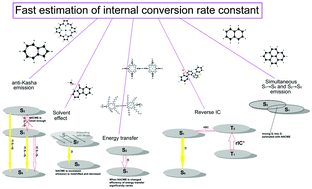Fast estimation of the internal conversion rate constant in photophysical applications
Abstract
An efficient method for estimating non-adiabatic coupling matrix elements (NACME) and rate constants for internal conversion (kIC) is presented. The method, based on Plotnikov's theory, requires only calculations of the electronic wave functions and the corresponding electronic excitation energies. Computationally expensive calculations of the derivatives of the electronic wave function with respect to the nuclear coordinates are avoided. When the main accepting modes of the electronic excitation energy are X–H vibrations, the present method can be used for estimating the efficiency of the energy transfer between donor and acceptor molecules. It can also be used in studies of the influence of hydrogen bonding or solvent effect on fluorescence quenching, in studies of vibronic effects of TADF (thermally activated delayed fluorescence) emitters, and for calculating kIC. Here, kIC and NACME are calculated for free-base porhyrin, magnesium porphyrin, azulene, naphthalene, pyrene and fluorenone interacting with a solvent molecule. Reverse kIC and NACME are further calculated for the T1 → T2 transition of dibenzothiophene-S,S-dioxide (PTZ–DBTO2), which is used in TADF applications. Finally, we estimate the efficiency of the energy transfer between two large porphyrinoid dimers.



 Please wait while we load your content...
Please wait while we load your content...